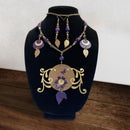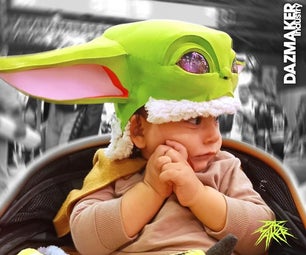Introduction: Bouquet of Fabric Flowers
This whole project was an experiment to test some supplies I had to see how they worked. I've made flowers from paper before but I love the idea of using fabric to sculpt them. I knew I should be able to do that with Stiffy, but I've never used it before so I thought there's no time like the present to try it out.
Supplies
Materials
- One square foot of poly-cotton blend fabric for every flower you wish to make
- Hemp, silk, or cotton cord (to coordinate with flower fabric)
- Mod Podge Stiffy (NOTE: Plaid Stiffy and Mod Podge Stiffy are the same thing)
- Mod Podge Fabric Glue
- 18 gauge wire (6" for every flower you make)
- All purpose glue to glue fabric or cord to wire (I used clear Tacky Glue)
- Tape yarn (also called ribbon yarn or T-shirt yarn). You can substitute with hemp cord or floral tape.
Tools
- Manual die-cutting machine
- Heart dies
- Thread scissors (these are small scissors for clipping threads or doing detail cutting work)
- Paint brush for glue and fabric stiffener
- Cookie cooling racks
- Side cutters
- Thin wood dowel (helps to curl flower petal edges but you can just use your fingers)
Step 1: Testing Stiffy
While this whole project is essentially a test, I specifically want to test how the Stiffy works and what precautions or alternates I need to take if it doesn't do what I want it to do.
The instructions say to soak the fabric (or paint it on or use your fingers to work it into the fabric), get rid of excess (but don't wring it because that will cause wrinkles), and that's it. There's instructions on creating a fabric bow that mention draping it over something and letting it dry for about 45 minutes "until slightly damp" before continuing to work. Does that mean I have to use a clip or something to hold the piece in shape while it dries? What about making shapes I don't want fully creased? Do I need supports or other tools to create the shapes I want? The only way to know is to test!
I cut out several shapes from a small corner of my test fabric, a poly-cotton blend. What I want to know is:
- How does this stuff even work?
- How long does it take to dry?
- How stiff is the fabric after it dries (can I still fold and unfold it)?
- Does it also act as a glue?
- Can I use it with Mod Podge Fabric glue (or other fabric glue) if not?
So, I grabbed a lid from a plastic container to use as my painting/dipping surface and started painting the stuff on some of the fabric pieces I cut.
What I learned
It was obvious right away it does not act like a glue. I used clips to hold the folds together while it was wet.
The fabric was fraying in my hands, but not too terribly. After it's dry, it doesn't fray at all, but I needed to trim off strings that stuck out with my thread scissors.
After about 5 minutes, I checked to see if the pieces were still wet and most were already mostly dry. The parts touching the wax paper were still wet, mostly likely from not having decent air flow. I shifted them around so they could get air. Nothing glued itself to the wax paper which was good.
I tried curling the edges of some of the pieces at this point (since they were already dry) to see if I could still work with the shapes and that worked well. I live in a relatively arid climate, so maybe that's why it only took 5 minutes, but 45 minutes to arrive to "slightly damp" as the instructions mentioned would be excessive anywhere on the planet.
After another 15 minutes, they were really stiff but still quite easily molded. This was useful when I attempted my next test of gluing pieces together.
I unfolded a couple leaves at their base to glue them together with the Mod Podge Fabric glue. The Stiffy did not interfere with the glue and those pieces stuck together nicely.
I realized I can wait for the fabric to dry completely and mold it how I want, so I don't have to use clips or anything like that while it's still wet or even slightly damp. I even attempted to mold the fabric the next day and it took to the new shape nicely.
Step 2: Cut and Prepare the Pieces
Have you ever noticed how many flower petals have a heart shape? For paper, you can use tear drop, leaf, or rounded heart shapes to form 3D flowers. You use a wood dowel to curl the tips and you wouldn't even know what the shape started as.
I have a set of heart shape dies that come in different sizes and shapes. I chose 5 sizes from about 7/8" tall to 1-3/4" tall. Those vary in width, as well. I decided I would do four of each size to allow them to overlap each other when wrapped around the wire. That's 20 heart petals for each flower.
For this project, I did three flowers, two from a dark purple fabric and one from a fabric in the same color scheme but with a white background. I cut out 8 each of the 5 sizes of heart-shaped pieces from dark purple, then 4 each from the white background fabric. You can double the layers of fabric on your die cutter's base to make this faster. I used my thread scissors to trim away the flowers that didn't quite get cut all the way through.
I then cut three 6" sections of 18 gauge wire, and three 8" sections of cord in a green color to serve as the middle of the flowers and cover up the end of the wire.
Paint hearts with Stiffy
Next I took each of the 60 hearts, one by one, and put them in my little plastic lid to coat with Stiffy. I coated both sides to be sure they were saturated.
I have a wire cookie cooling rack that I set the pieces on so they got good air flow. I didn't expect any dripping, but I put wax paper under the racks just in case. I realized early enough that the hearts were gluing themselves slightly to the racks, so I pulled them up and readjusted them so they wouldn't do that. I didn't need to do that often as they dried quickly.
Make the stamen
While doing this project, I learned that this really isn't the technical term but it's close. The stamen is the pollen-producing male part of the flower, several of which surround the female part, the carpel. Collectively, the stamen are called the androecium. But I wonder how many people recognize that word over stamen?
Anyway, we're just producing something fluffy to cover the end of the wire and look somewhat like the middle of a flower.
While holding one end of the cord, I looped it up and down several times (each loop a little longer than a half inch) until I had about an inch left over. Then I tightly wrapped that loose end over the bottoms of the loops. Then I painted Mod Podge Fabric glue over that end and wrapped it around the outside and held it for a few seconds. I then painted more glue on that knot to be sure it was coated well.
While it was still wet, I pushed the end of a wire section in through the bottom and pinched the cord tightly over the wire. I did that for all three wires and let them dry about 20 minutes.
Step 3: In a Sticky Situation
Before we even start here, you need to know:
- This is messy
- This will take patience
- Your fingers will get goopy
- Be prepared to wash your fingers and paint brush regularly
OK. Now that's out of the way, let's begin!
You'll notice in the pictures that my paint brush looks really rough. This is a kid's brush, probably made with plastic bristles. I have no love for it, but it has served me well in glue application. I don't want to use my good brushes for glue or similar materials because I don't want them getting globby. I suggest using a paint brush you don't love for this project.
To wash the glue out of the brush and off your fingers, you just need warm water and soap.
We'll start by gluing the smallest hearts on first and then work our way to the biggest ones. If you have hearts that look about the same size but are different heights or widths, use the shorter ones closer to the middle and longer ones outside of those.
I started by painting glue on the bottom of the stamen knot and a little onto the wire. I also painted the bottom portion (the pointy part) of one of my smallest hearts. Paint the side that you want facing up (the front of the fabric). That's what you will see when the project is done.
Then I folded the sticky bottom of the heart over the knot and held it for about 15 seconds. Then I painted more glue on the outside of that heart, and the inside of the bottom of another small heart. I placed the second heart about a half turn over from the first, so the petals overlap but aren't lined up exactly. The hump from one side of the heart should cover the dip in the middle of the previously glued one. I did all four small hearts like this until they wrapped completely around the wire.
Then I laid that one down to dry and started with the smallest hearts on another flower stem. And when that one was done, I did the final flower stem. I washed my fingers and brush.
I let them all dry until they were no longer tacky, which was about 20 minutes.
I folded the tips of the petals (the humps on the hearts) out slightly using my fingers and sometimes a thin wood dowel (which is actually a repurposed wood skewer). Just wrap the tip over the dowel and press and hold. Or use your fingers to crease the tip backwards. You want to do this with each ring of petals before adding the next because they will be harder to access with bigger petals outside of them.
Then I started on the next row of heart petals. Same deal, glue on bottom of already glued hearts, glue on bottom of new hearts, fold and hold, repeat with a half turn of the next heart. Wash fingers and paint brush and let dry a bit. Fold tips down and do the next round and the next until all the hearts are glued on.
In the fold and hold part, the outer two rings of hearts needed to be held longer before the glue took hold. I believe that was because just the tips were being held and they didn't reach all the way around the base since it was thick with the previous three rows. But, I just held them until they seemed steady and moved on to the next.
When I was done with the final ring of hearts, I let all the flowers dry about a half hour. Then I folded the bottom petals out more, bending them back at about their half-way point and curling the top parts back a little. This made the flowers more open.
Step 4: Wrap It Up
The final step was dressing up the wire stem. You could use floral tape for this step, but I already had a pretty pink tape yarn that worked well with the fabric colors in the flowers. If you have floral tape you won't need to glue it down. Just wrap the bottom of the flower (a little higher than where the heart points meet) around once, then angle your tape slightly to wrap down the stem.
For my tape yarn (or cord if that's what you're using), I needed to glue the end down and glue along the wire as I wrapped. I used both Mod Podge Fabric and clear Tacky Glue to pull this off.
I dipped my finger in the Mod Podge Fabric glue, and dabbed a little on the base of the flower and a little on the end of my yarn. I placed the end of the yarn down where I put glue on the base of the flower and held it there for about 15 seconds. Then I wrapped the yarn once to cover the end and dabbed more glue down to secure it.
Then I angled the yarn down slightly to begin my downward wrapping of the wire stem. As I wrapped, I kept dripping a little Tacky Glue on the wire to hold the yarn to the wire. I used Tacky Glue because it is an all purpose glue that works on metal. The Mod Podge Fabric probably would have worked if I'd overlapped the yarn, since that would be gluing fabric on top of fabric. But the Mod Podge Fabric has a rubbery feel when it dries and the Tacky Glue doesn't.
When I got to the end of the wire, I went back to using Mod Podge Fabric to secure the yarn by gluing it back over itself. I trimmed the yarn, then dabbed Mod Podge Fabric under the end. Then I pressed it down and rubbed more Mod Podge Fabric on top of the cut end. I held it there for about 20 seconds.
I wrapped the wires of the other two flowers the same way and was ready to show them off.
Step 5: Show the Flowers Off in a Matching Vase
I pulled a soda bottle out of the recycling bin for this. I peeled the label off and cut a piece of coordinating fabric about the same size as the label.
I spread clear Tacky Glue all over the back of the fabric, using my finger to spread it right over the edges to make sure they wouldn't peel up when I glue it down. I smoothed the fabric over the glass, starting from one edge to smooth it up and over. I made sure there were no air bubbles, creases, or lumps. Then I let it dry as I washed off my hands.
Finally, it was show time! I put my three fabric flowers in the bottle so they could shine!

Runner Up in the
Fabric Challenge














2 Comments
11 months ago on Introduction
Absolutely love this! Thank you for the wonderful directions. Beautiful,!
Reply 11 months ago
Thank you! This was really fun to make and learn from.